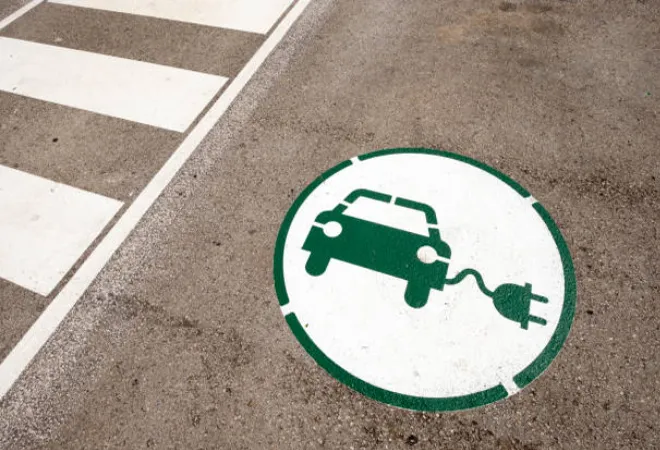
The race to transition towards an electrified transportation scenario is gathering steam globally. With the much-anticipated autumn’s climate change event of COP 26 in Glasgow around the corner, stakeholders are rallying around the idea of electric vehicles (EV) in an attempt to mainstream the environmental and economic case for e-mobility solutions across the world.
Different stakeholders and decisionmakers are treading on different paths to further this e-mobility discourse. Governments, including city administrations, are pursuing the route of target announcements and pushing for policies aimed at catalysing the uptake of such vehicles. Recently, the Biden administration announced a target of 50 percent of total vehicle sales to be electric by 2050. Many nations have propounded similar target-based announcements.
Governments, including city administrations, are pursuing the route of target announcements and pushing for policies aimed at catalysing the uptake of such vehicles.
Interestingly, in India, there have been statements from the Union Minister of Transportation, estimates from the national think-tank, the NITI Aayog, and other recorded sources predicting the trajectory of adoption of EVs or phase-out of Internal combustion engine (ICE) vehicles. However, there has been no official institutional commitment by the Government of India on this front at the global stage.
Apart from the governments, various business conglomerates and corporate houses have also followed suit by announcing their future plans and targets of electrifying their vehicle fleets. Prominent global names include automakers like Ford, General Motors, and other corporates like Uber, Amazon, FedEx along with Indian businesses like the Reliance Group, Mahindra and Mahindra, Vedanta, Zomato, Flipkart, amongst others.
On the public policy front, various think tanks have churned out numbers and statistics with respect to the e-mobility transition. Many policy-based researchers have attempted at capturing the opportunities, costs, benefits, and challenges through statistical and economic indicators like investments, employment, techno-economic viability, amongst others. Some have also estimated the emission-savings because of an electrified mobility scenario.
Prominent global names include automakers like Ford, General Motors, and other corporates like Uber, Amazon, FedEx along with Indian businesses like the Reliance Group, Mahindra and Mahindra, Vedanta, Zomato, Flipkart, amongst others.
In the Indian context, the following table summarises the indicators crafted by academicians and think tanks that have been used to headline the e-mobility transition so far.
| Sl. No. |
Indicators |
Details/Values/Range |
| 1 |
Emission reduction potential |
CO2 emission to decrease by at least 29 percent, PM 2.5 to decrease by at least 79 percent in business-as-usual scenario for Power Generation Mix by 2030 |
| 2 |
Investment opportunity |
By 2030:
● US $177 Billion in Vehicle Manufacturing
● US $2.9 Billion in Charging Infrastructure
● US $12.3 Billion in Battery Manufacturing
● US $206 Billion in Revenues from Sale |
| 3 |
Employment potential |
10 million jobs by 2030 |
| 4 |
Opportunity savings in oil imports |
INR 1.1 lakh crore to 2.2 lakh crore per year |
Although these indicators and developments are prominent, they have a few problematic characteristics in the way they are used to further the policy discourse around e-mobility in India and globally.
First, these are good for optics and image creation but often hollow when it comes to concrete plan of action or follow-up. For instance, the target-based announcements, the ‘launch’ of policies and regulations and the fetish of quantifying benefits appeases the popular narrative around e-mobility transition.
Second, because of this trait, such developments dominate the public perception, often informing the potential investors and consumers of e-mobility solutions with the partial information that they represent.
Finally, the significant component of ‘why’ and ‘how’ these indicators can be actualised remains in the backdrop of the catchy headlines limiting the quality of discussions on the ways and means to achieve them.
These traits make such a discourse problematic for various reasons.
While the government can potentially save a grand amount from EVs in terms of import bills, there are other sources of revenues for the governments, particularly of the state governments, which are at the danger of decreasing.
For one, numbers and statistics can be easily twisted to further a particular narrative, often resulting in a significant scope of biases governing the narrative. This might result in a shift from evidence-based policymaking to policy-based evidence generation. Take the oil import savings for instance. While the government can potentially save a grand amount from EVs in terms of import bills, there are other sources of revenues for the governments, particularly of the state governments, which are at the danger of decreasing. One of these is the sales tax/value added tax collected through sale of petrol and diesel. The following table showcases the amount of sales tax realised by some of the states of India and the proportion of this sales tax to the overall tax revenues of those state governments (own tax revenues).
Table 1: Source: Budget Analysis, PRS Legislative Research and Ministry of Petroleum and Natural Gas
| Name of State |
Sales tax/VAT through petroleum, oil and lubricants (POL) (in crores) for 2019-20 |
POL as percent of own tax revenue for 2019-20 |
| Andhra Pradesh |
10,168 |
17.65 |
| Delhi |
3,833 |
10.48 |
| Gujarat |
15,337 |
19.41 |
| Karnataka |
15,381 |
15.02 |
| Maharashtra |
26,791 |
14.17 |
| Rajasthan |
13,319 |
22.48 |
| Telangana |
10,045 |
14.86 |
| West Bengal |
7,534 |
12.42 |
This highlights that many states like Rajasthan, Andhra Pradesh, and Maharashtra are at the risk of losing out on a significant chunk of revenue source if EVs take over the transport scenario.
Furthermore, a subsidised culture of EV manufacturing and sales limits the opportunity to realise this deficit through alternate revenue sources such as registration tax, GST and road tax, all of which are being exempted on EVs in a majority of the EV policies. Thus, a gain for the central government through import bill savings can prove to be a burden for state governments. This becomes even more grave a concern in the backdrop of COVID and the centre’s reluctance to aid the state governments’ finances directly, hence, raising concerns over the resilience of the state to finance EV transition in the first place.
Similarly, various scientific reports have pointed out that the lifecycle emission assessment of EVs have mixed results. Although there are no tail-pipe emissions involved with them, there are emissions involved at the stages of manufacturing and operations, especially in a carbon-intensive energy generation scenario. This is the reason why CO2 emissions are likely to increase from electric buses, and PM 2.5 emissions are also poised to increase in some electric cars in the current power generation scenario in India. Furthermore, the technological waste that huge scale manufacturing of batteries and vehicles will generate is another problem in the making.
Also, take the investment-employment numbers for that matter. As standalone figures, they represent significant numbers which align well with India’s economic ambitions. But these can be twisted to strengthen an alternate narrative. At a basic cursory level assessment, a US $190 billion investment opportunity till 2030 resulting in 10 million jobs imply merely seven jobs per crore of investment. Ola’s recent investment in Hosur’s plant also turns out to be four jobs per crore of investment as compared to conventional automobile sector which has created around 123 jobs per crore of investment over the last 10 years in India.
The technological waste that huge scale manufacturing of batteries and vehicles will generate is another problem in the making.
This doesn’t mean that the indicators are irrelevant. It simply implies that the magnitude of such indicators at the face-value is, perhaps, not the ideal issue for discussion, brainstorming, and dialogues. Instead, the processes and motives behind such indicators are equally, if not more, important from a policy perspective.
In this context, the pertinent point of inquiry needs to shift to quality of investments from mere monetary return on investments. The discussions need to focus on creation of good quality and sustainable income opportunities instead of over-focusing on the number of jobs only. In other words, while advocating for green jobs due to the e-mobility transition, one needs to encounter the nature of such jobs so created, especially when the track record of the Indian economy has historically been below-optimal on that front.
Such an approach which delves into the questions of ‘how’ and ‘why’ by inquiring into the processes and people involved in the e-mobility transition, or any transition for that matter, is bound to produce results which can address the legacy issues of exclusionary (economically) and exploitative (environmentally) development in the country.
The element of ‘justice’ in a ‘just’ e-mobility transition needs to come from asking difficult questions and diligently searching for their answers.
With such a paradigm shift, the centre of discussion will shift from the headline numbers to the plan of action of implementing the same. The sidelined mention of avoiding commuting if not necessary, shifting to non-motorised transportation, strengthening public transportation, financing an inclusive e-mobility transition, capitalising on the employment opportunities, amongst others can be brought to the forefront of policy and planning discourse. Hence, the element of ‘justice’ in a ‘just’ e-mobility transition needs to come from asking difficult questions and diligently searching for their answers.
Every stakeholder should ask such difficult questions from oneself and each other. Some of the tentative ones include:
- What is the shared goal of the ecosystem of existing stakeholders with respect to the future of mobility?
- What are the indicators which can be used to measure the performance of stakeholders aptly for achieving this shared goal?
- How have the institutions and their operations so far fared in the mobility ecosystem with respect to achieving the aforementioned shared goal?
- How can the existing challenges/inefficiencies be addressed and existing opportunities be capitalised?
- Under this pretext, how can e-mobility solutions be designed, implemented, and monitored such that it furthers the performance of the ecosystem to achieve the shared goal?
- How can fallouts and unintended consequences be identified, monitored, and addressed seamlessly?
Mere numerical or statistical game play will create an illusion of solutions at best and amplify the problem at worst.
The views expressed above belong to the author(s). ORF research and analyses now available on Telegram! Click here to access our curated content — blogs, longforms and interviews.




 PREV
PREV


